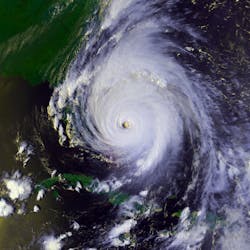From the east coast to the west, security executives should be aware that it's "natural disaster season" -- as two of nature's biggest threats -- hurricanes and wildfires -- pose a serious risk to business continuity.
According to preparemybusiness.org -- a website co-sponsored by the U.S. Small Business Administration (SBA) and Agility Recovery Solutions, a disaster recovery firm -- following a disaster, statistics show 90 percent of companies fail within a year unless they can resume operations within five days.
Wildfire season on the west coast is already off to a blazing start. Colorado is on the brink of one of its worst fire seasons in history, blamed on very high temperatures and a very low snowpack, which left mountains tinder-dry. After 10 days, the largest fire, the High Park Fire near Fort Collins, has incinerated 189 homes, and almost 2,000 are still threatened. It has burned 93 square miles costing $17.2 million so far, according to USA Today. The fire was set by lightning June 9.
Other wildfires are burning right now from Wyoming, to Arizona, to Southern California...and even in midwest states like Nebraska.
Here are a few wildfire preparedness steps from Agility Recovery (the full checklist for before, during and after a wildfire is available at http://www2.agilityrecovery.com/assets/SBA/wildfiresba.pdf):
- Keep an adequate number of appropriate fire extinguishers in strategic locations (such as near loading docks and waste collection areas) and maintain them properly.
- Train employees on how to use extinguishers correctly.
- Consider maintaining a water supply at your facility to control small fires until emergency personnel can arrive.
- If a water pump uses electrical power, consider obtaining a gasoline- or diesel-powered pump or generator in case electricity is cut off during a fire.
- Have appropriate tools, such as rakes, axes, saws, buckets and shovels, available to help control small fires while waiting for emergency personnel to arrive.
On the east coast, security executives should be braced for this year's hurricane season, as a third tropical storm (Chris) has already formed in the Atlantic Ocean. According to the National Oceanic and Atmospheric Administration (NOAA), conditions in the atmosphere and the ocean favor a near-normal hurricane season in the Atlantic Basin. For the entire six-month season, which began June 1, NOAA’s Climate Prediction Center says there’s a 70 percent chance of nine to 15 named storms (with top winds of 39 mph or higher), of which four to eight will strengthen to a hurricane (with top winds of 74 mph or higher) and of those one to three will become major hurricanes (with top winds of 111 mph or higher, ranking Category 3, 4 or 5). An average season produces 12 named storms with six hurricanes, including three major hurricanes.
Here are some considerations for before-the-storm business continuity from Agility (the full checklist for before, during and after a storm is available at http://www2.agilityrecovery.com/assets/SBA/hurricaneprepsba.pdf):
- Stay up to date on a storm's progress via radio, TV, Internet, etc.
- Determine safe evacuation routes.
- Have an emergency communications plan in place long before a threat presents itself.
- Back-up all data on servers as possible, and bring the back-up materials with you if evacuated.
- Turn off all non-critical electrical devices in the facility.
- Check the integrity of uninterruptible power supplies (UPS) and move them off the floor if possible.
- Alert a third party of your organization's relocation plan.
- Protect or relocate vital paper records, especially insurance policies.
- Install shutters, remove loose outside debris, and anchor or relocate any outside equipment.



